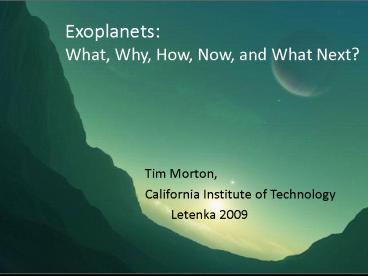Exoplanets: What, Why, How, Now, and What Next - PowerPoint PPT Presentation
1 / 27
Title:
Exoplanets: What, Why, How, Now, and What Next
Description:
Use 'wobbles' and 'blinks' to try to infer characteristics of exoplanets ... The Wobble. The Wobble. Radial Velocity. Relies on Doppler effect (demonstration) ... – PowerPoint PPT presentation
Number of Views:407
Avg rating:3.0/5.0
Title: Exoplanets: What, Why, How, Now, and What Next
1
Exoplanets What, Why, How, Now, and What Next?
- Tim Morton,
- California Institute of Technology
- Letenka 2009
2
What is an Exoplanet?
- Exoplanet is short for Extra-solar planet,
meaning a planet orbiting a star other than our
sun. - First exoplanet (Peg 51) discovered in 1995
- Jupiter-like, 4-day orbit
- Today, 358 known (282 within 200 pc and
well-characterized) - Check out exoplanets.org or exoplanets.eu for
current stats - One of the most exciting topics in astronomy!
3
Why do we care?
- Fundamental motivation Are we alone in the
Universe? - Easier question Are there planets around other
stars that can possibly support life? - Two ways to approach this question
- Find other planets that can support life (i.e.
liquid water) - Ask the question How common are planetary
systems like our Solar System?
4
Habitable Zone
5
How are exoplanets found?
- Direct detection (lt10) Look directly for light
coming to us from exoplanets - Indirect methods (gt300) see the effects of a
planets presence by looking at stars - Wobbles (Radial Velocity, Astrometry)
- Blinks (Transits, Microlensing)
- (Why is direct detection so hard?)
6
Direct Detection
7
Indirect Detection
- Use wobbles and blinks to try to infer
characteristics of exoplanets - Existence!
- Mass (M)
- Distance from host star (a)
- Radius (densityrocky or gas?) (R)
- Atmosphere composition? (Life?)
- Different methods can determine different
characteristics
8
The Wobble
9
The Wobble
- Radial Velocity
- Relies on Doppler effect (demonstration)
- Gives Msin(i) (orbit orientation unknown)
- Gives separation
- Most exoplanets so far discovered with this
method - Astrometry
- Relies on very accurate position measurements of
host star - Gives M,a, independent of inclination!
- Very hard! (But first one just found this year)
- Best chance to find an earth around a nearby
sun-like star (with a space mission)!
10
The Blink
- Transits
- Simple concept (demonstration)
- Gives M, a, radius (density), and maybe much
more! (exciting follow-up possible) - 25 exoplanets found this way
- Have to be lucky!
- Microlensing
- More complicated
- Get M, a, but no follow-up possible
11
Transits
12
The Blink
- Transits
- Simple concept (demonstration)
- Gives M, a, radius (density), and maybe much
more! (exciting follow-up possible) - 25 exoplanets found this way
- Have to be lucky!
- Microlensing
- More complicated
- Get M, a, but no follow-up possible
13
Microlensing
Gravity bends light (video)
Animations by Scott Gaudi, Ohio State University
14
The Blink
- Transits
- Simple concept (demonstration)
- Gives M, a, radius (density), and maybe much
more! (exciting follow-up possible) - 25 exoplanets found this way
- Have to be lucky!
- Microlensing
- More complicated
- Get M, a, but no follow-up possible
15
Now What have we found?
- Mostly Hot Jupiters
- Recently, more Neptunes and Super-Earths
16
Now What have we found?
- Mostly Hot Jupiters
- Recently, more Neptunes and Super-Earths
17
Exciting News!
18
Major current (and future) projects
- Radial Velocity
- Ongoing long-term ground-based monitoring of
sun-like stars - Monitoring of M-dwarfs (like Gliese 581)
- Transits
- HATNet (ground-based small telescope network)
- Kepler (space-based, launched earlier this year!)
- MEarth (ground-based M-dwarf transit search,
coming online now) - Targeted follow-up of RV-discovered planets (me!)
- Microlensing
- Ongoing ground-based searches
- Future space-based missions planned
- Direct Imaging
- Continuing search for wide-separation planets
- Astrometry
- Space Interferometry Mission (10 years?)
19
HATNet
Automated network of small (10cm) telescopes
around the world looking for transits around
bright stars
20
Kepler
- Will stare at the same 100,000 stars
continuously for 5 years - Will be able to discover Earths transiting
stars like our Sun
21
Kepler First Light!
22
MEarth project Mt. Hopkins, AZ
- Goal monitor large numbers of M-dwarf stars to
look for transiting planets - Remember, M-dwarfs have close habitable zones
(like Gliese 581)
23
Space Interferometry Mission
Will measure positions of stars very precisely
will be able to detect wobbles caused by
earth-sized planets around nearby stars!
24
Microlensing Planet Finder?
25
Different methods find different planets
26
What Next? (Future!)
- Surveys will establish good statistics of
exoplanetary systems - Many habitable zone planets will be found
- SIM especially will find HZ planets around nearby
stars - Targeted follow-up observations will be able to
characterize exoplanet atmospheres - Find signatures of life?
- Targeted SETI communication?
27
Maybe soon?































